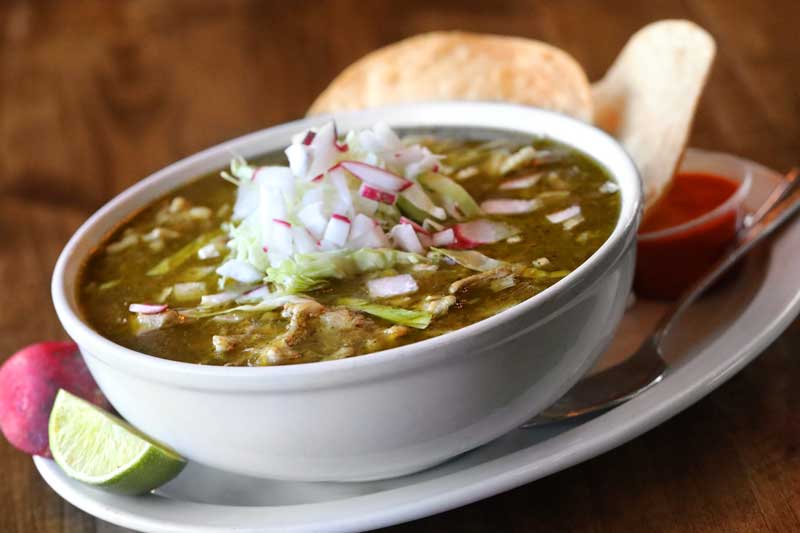With chunks of tender meat and hominy, this Mexican stew is a cause for celebration.
The first time I tried pozole, a traditional Mexican stew, also was the first time that I was introduced to nutty, puffed-up hominy in its whole form. I couldn’t get enough of it. Made from dried corn kernels that have been soaked in a lye or lime solution to soften the outer hulls, hominy is arguably the star ingredient in pozole. It soaks up the flavorful broth of the pozole, enriched with the addition of salsa verde or rojo, and adds a complementary texture to the tender pork (or sometimes chicken) found in the stew. The dish is garnished with toppings such as shredded cabbage, chopped onions, cilantro, sliced radishes, avocado, and lime wedges and served with crunchy tostadas.
The origin of pozole dates back to the Aztecs in pre-Colombian Mesoamerica who considered corn a sacred plant and even included it in their mythology, worshipping Chicomecóatl, the goddess of sustenance and maize. The stew remains popular throughout Mexico today and usually is made to mark events such as Christmas or birthdays.
“It’s not a dish that you have every week or every month in your house. It’s for special occasions,” says Victor Mendiola, chef at Casa Baeza in Truckee, who grew up eating pozole in Michoacán, Mexico.
Mendiola makes a pozole rojo, starting first with a tender bone-in pork butt cut into pieces and cooked in water with onion, garlic, cumin, oregano, and bay leaves. He roasts more onion and garlic to blend and add to the broth, as well as a brilliant-red salsa rojo made from rehydrated guajillo peppers. The hominy is added near the end to ensure it doesn’t become mushy.
“It’s all about the toppings,” Mendiola adds. “For me, the lime is the most important, but you can add whatever you want to make it just as you like it.”
Mendiola suggests making the pozole a day ahead of when you plan to eat it to give the flavors time to develop — or perhaps save yourself from spending too much time in the kitchen on the day of a special occasion.
Meanwhile in Reno, chef Dora Rivera cooks up a pozole verde at Chihuahua’s Cantina and Grill in Reno and Winnemucca.
“You don’t see green pozole as much, so I wanted to try something different,” Rivera says.
Rivera says the key is starting with a quality piece of bone-in pork shoulder that has just the right amount of fat.
“You don’t want it overly [fatty] or old. You want fresh pork. I like the bone in because the bone is going to give a lot of flavor,” Rivera explains.
Whereas Rivera’s process for cooking the meat is similar to Mendiola’s, her pozole differs with the addition of a vibrant salsa verde made from fresh tomatillos, serrano peppers, cilantro, onions, garlic, cumin, oregano, and chicken bouillon. Though some non-traditional recipes may tell you to save time with store-bought salsa, Rivera cautions against this.
“I think it’s all of the fresh ingredients that makes our pozole so good,” she says. “It’s really very easy!”
Claire McArthur has made some seriously inauthentic batches of pozole in her lifetime and can’t wait to whip up Dora Rivera’s pozole verde with absolutely no store-bought salsa involved.
RESOURCES
Casa Baeza
10010 Bridge St., Truckee
530-587-2161 • Casabaezatruckee.wordpress.com
Chihuahua’s Cantina and Grill
7111 S. Virginia St., Ste. C1, Reno • 775-683-9846
71 Giroux St., Winnemucca • 775-625-4613
Chihuahuasgrill.com
Pozole Verde
(courtesy of Dora Rivera, co-owner and chef, Chihuahua’s Cantina and Grill in Reno and Winnemucca. Serves 6 to 8)
5 to 6 pounds fresh, bone-in pork butt or shoulder (trimmed and cut into 1½- to 2-inch pieces)
1 (10-pound) can hominy, drained and rinsed
6 to 7 cloves garlic
½ medium white onion, chopped
3 bay leaves
2 tablespoons salt
For salsa verde
2 pounds tomatillos
4 cloves garlic
½ white onion, roughly chopped
4 to 5 fresh serrano or jalapeño peppers
2 bunches cilantro
1½ tablespoons oregano
1 tablespoon ground cumin
1 tablespoon salt
1 tablespoon chicken base (chicken bouillon)
Garnishes: fresh lime wedges, chopped cilantro leaves, thinly sliced radishes, thinly sliced cabbage, diced avocado
In a large pot, bring 5 quarts of water to boil. Rinse pork with water and add it to pot. Meanwhile, in a blender, blend garlic, onion, and bay leaves with 2 cups water and add to pork. Add salt and let it cook for 90 minutes or until meat is tender. Add hominy and simmer for 15 minutes. Set aside on low heat (with the cooking liquid).
Bring a large pot of water to a boil over medium-high heat. Add tomatillos and cook about 8 minutes. Remove from heat, drain, let tomatillos cool, and add to blender with the garlic, onion, cilantro, oregano, cumin, salt, and chicken base for salsa verde and purée.
Add purée mixture to the pot with the meat and cooking liquid. Mix and bring to a simmer. Adjust seasoning with chicken bouillon. To serve, ladle into bowls and top with garnishes. Provecho!


